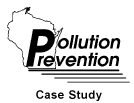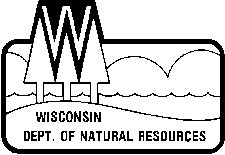
|
Outboard Marine Corporation (OMC)
Substitution for Chromate Conversion |
| Standard Industrial Classification
(SIC) |
Marine Engine Components/3519 |
| Type of Waste |
Chromium |
| Strategy |
Process Modification |
| Company Background |
Outboard Marine Corporation (OMC)-Milwaukee
employs 400 people and manufactures many of the components used for production of the
Evinrude and Johnson outboard engines. The Milwaukee manufacturing facility has roots in
the Milwaukee area dating to 1921. The manufacturing operations include machining, heat
treating, investment casting, polishing and electroplating operations. The operations with
the most impact on hazardous waste generation, and the greatest potential for reductions,
are the electroplating and chemical coating operations. The OMC-Milwaukee facility has an
aggressive hazardous waste reduction program in place. The facility has targeted Chrome
(VI) for elimination. |
| Original Process |
OMC used conversion coating on aluminum
propellers prior to powder painting. The process serves two functions. First, the
conversion coat enhances the corrosion resistance of the aluminum. Second, it prepares the
surface for powder painting and acts as a primer. |
| Scale of Operations |
In 1993, OMC began a world-wide
restructuring of its facility manufacturing capacity. The restructuring transferred
complete responsibility for production of aluminum propellers (except die casting) to
OMC-Milwaukee. This included transferring the chromate conversion coating line. |
| Motivation |
The OMC-Milwaukee facility had already
initiated pollution prevention projects to eliminate chrome (VI) from the facility by
eliminating various chrome plating baths. |
| Pollution Prevention Process |
The original process was a chromate
conversion coating in which the chromate bath contained both trivalent and hexavalent
complex chrome salts. The process modification substituted a conversion coating bath
containing cobalt to replace the chromium salts. |
| Development |
The requirements for the conversion coating
of aluminum are contained in product engineering specifications issued by OMC. The
engineering group was approached about substitutes that they had been testing; two
processes appeared promising. Engineering agreed to a program where OMC-Milwaukee would
provide coated and painted samples from the new processes for evaluation. They also agreed
to accelerate paint adhesion and corrosion testing. Testing was initiated in September,
1993, with the understanding that a final decision would be made by November, 1993. This
left the minimum time required to purchase chemicals and make equipment modifications
prior to the actual transfer and the start of production in January, 1994. Testing of
Parker-Amchem "Alodine 2000" indicated that this product provided both paint
adhesion and corrosion resistance equal to the chromate bath currently in use. |
| Material/Energy Balance |
Original Process
For an industrial wastewater treatment plant with a flow of 10 gal/min, chrome reduction
of rinse waters was estimated to cost $9,000 annually. This figure is based on operating
and maintenance costs of $3-$4/1000 gallons treated. Disposal of D007 waste (contains
chromium) was about $1,600/year, based on a $400/drum transportation and disposal fee.
Historical data showed the average chromate bath life to be six months.Pollution Prevention Process
There were no reductions in treatment of rinse waters, no hazardous air pollutants (HAPs)
and no hazardous waste products.
Common to Both Processes
Wastewater treatment of rinsewaters for heavy metal removal through precipitation was
employed. |
| Economics |
Capital Costs
No capital costs were associated with this project.Operating
Costs
Operational costs for the "Alodine 2000" bath are estimated to be
$0.04-$0.05/mg/1000ft2 with a 50 mg/ft2 target weight. This compares
to a $0.03-$0.04/mg/1000ft2 cost of a chromate bath with a 70 mg/ft2
target weight. Based on coating requirements, this translates to a 12 percent cost
advantage at the OMC-Milwaukee facility.
Payback Period
Immediate |
| Benefits |
The facility benefited from: reduction of
hazardous air pollutants; reductions in heavy metal loading in wastewater discharges; and
the elimination of chrome bearing (D007) hazardous wastes. |
| Problems Encountered |
In January, 1994, no commercial
installation of the "Alodine 2000" process for the conversion coating of
aluminum existed. OMC-Milwaukee decided to become the pilot plant and place strict testing
criteria on production process and parts for the first year. With completion of the first
year's production, no quality problems have surfaced with the parts or the process. |
| Technology Transfer |
The product was originally formulated by
the Boeing Aerospace Company but was licensed to Parker-Amchem where development of the
product and the total process package continued until it was suitable for general
commercial use. "Alodine 2000" conversion coatings on aluminum is a technology
that is easily transferable to many industries that use a chromate conversion system. It
requires little or no modification to existing equipment. |
| Company Address |
Outboard Marine Corporation
(OMC) Milwaukee
6101 North 64th Street
Milwaukee, WI 53218-1562
414/438-5097 |
| Industry Contact |
Mr. Jim Bonifield, Division Metallurgist
414/438-5126 |
| Pollution Prevention Resources |
Free, On-site Technical Assistance
University of Wisconsin Extension
Solid and Hazardous Waste Education Center
Milwaukee area: 414/475-2845
Remainder of state: 608/262-0385Pollution Prevention
Information Clearinghouse
Wisconsin Department of Natural Resources
Hazardous Waste Minimization Program
608/264-8852, 608/267-9523 or 608/267-3763 |
 |
Bureau of Cooperative Environmental Assistance
Wisconsin Department of Natural Resources
P.O. Box 7921
Madison, WI 53707
608/267-9700
PUBL-TS-026 95 |
|

